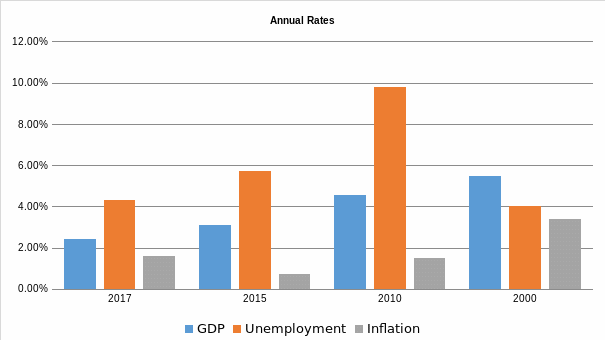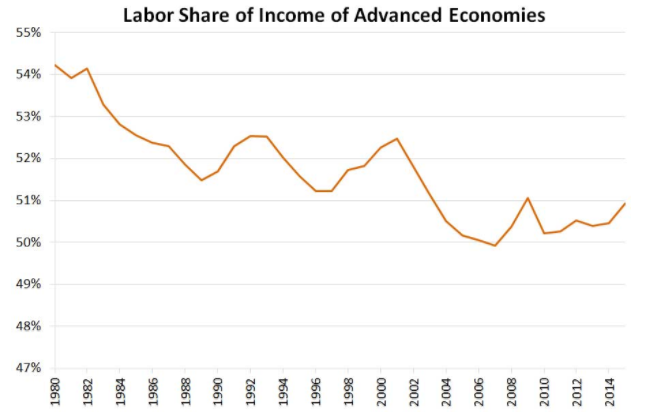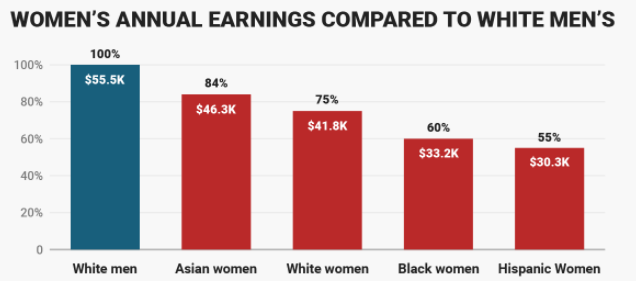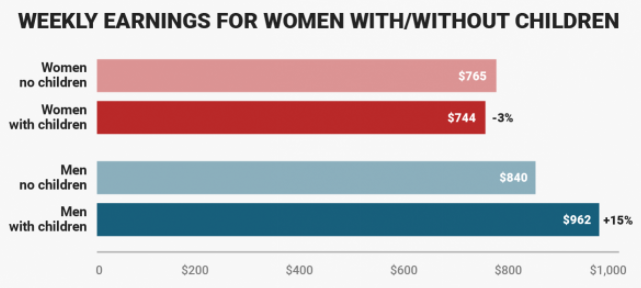American society has to face a number of challenges in economics, politics, and healthcare. Human relationships depend on different factors, and economic factors play an important role. Society is divided on rich and poor, and this kind of inequality develops in the United States in its own way. During the last several decades, income inequality has dramatically increased and led to the creation of new problematic areas and gaps in society.
This issue was one of the central pieces of Hillary Clinton’s campaign in 2015, proving that income inequality is not only an economic concept that had to be discussed in terms of economic theories and frameworks, but a political factor that may be a threat to public confidence (R.A., 2015).
People want to know what may cause income inequality changes in the United States and clarify if there is a connection between income inequality, labor share changes, globalization, technological progress, taxes, education, and gender/race disparities. In this paper, the central theme is the essence and causes of income inequality changes in the United States during the last two decades. The evaluation of the changes promotes an understanding of the relationships between inequality of individuals and the economic growth of the country.
The U.S. Economic Situation
The United States is characterized by a successful and healthy economic outlook in 2017 (Amadeo, 2017b). Unemployment, GDP growth, and inflation are at their normal points without any evident threats being dangerous to the US population and economy as it is shown in Figure 1 (Amadeo, 2017b). It is expected that the country is able to avoid the complications of the financial crisis that covered the whole world due to unstable political relationships and constant industrial changes.

Trump’s presidency is a crucial point in the economic situation of the country. The President has already made promises to create new job places and focus on their financial well-being (Amadeo, 2017b). However, people’s doubts usually have reasons. Certain premises to the financial crisis and economic instability were observed during the last decades, and many researchers and economists believed that inequality was a root cause of financial and economic problems (Berg& Osrty, 2013; R.A., 2015; van Treeck, 2014). Therefore, it is necessary to investigate the concept of income inequality and its peculiar features in the United States.
Income Inequality Definitions
Income inequality is a difference that exists in the well-being of different individuals or groups of people. Watkins and Brook (2016) define inequality as a “symptom of underlying economic problems” and a cause of the economic slowdown in the country that aims at favoring rich people only (p. 6). It is a condition of a rapid economic growth that is usually related to high incomes and high levels of efforts which promote the growth of poverty and the inability to control economic relationships in the country and at the international level (Gottheil, 2014).
The peculiar feature of income inequality is that the country may be on the list of the richest countries in the world and have the highest inequality rates. There are two methods to measure income distribution: the Lorenz curve that demonstrates a percentage of total income among the population and the Gini coefficient that transforms the curve into one particular number (Gottheil, 2014). At this moment, the United States has the highest percentage of total global personal wealth that is about 41.6% compared to China’s 10.5% or the UK’s 5.6% (Sherman, 2015). At the same time, the United States’ Gini index is about 0.481 (Semega, Fontenot, & Kollar, 2017).
These numbers prove that overall wealth is concentrated in the hands of fewest Americans. The changes in income inequality were significantly observed at the end of the 20th century when capitalism was a core political approach, and people did not have a chance to use appropriate social services.
There are certain economic, social, and demographic factors that may influence income levels of the population. Ryscavage (2015) explains that it is not enough to use one social or one economic factor in order to explain why income levels may vary and suggests combining individual economic factors like the lack of involvement with technologies, demographic factors like age or race, and social factors like education or marital status.
According to Cheung and Lucas (2016), income inequality may be associated with a social comparison of income that can be used to predict life satisfaction among the citizens. Inequality is linked to the incomes of poor and middle-class people, as well as living standards, political activities, and public health. Therefore, to avoid complications and negative outcomes, it is important to learn the causes of income inequality in the United States and clarify if there are some groups of people or organizations that may gain control over the situation in the country.
Income Inequality Causes
Despite numerous positive achievements in international relations, politics, healthcare, and education, there is still a split in the US population that is based on the possibility to obtain different income levels and the inability to change the situation and provide people with a chance to earn. Many researchers and economists fail to give clear reasons for why income inequality cannot be stopped in the United States and continue introducing new sources of uncertainty, personal and household problems, and working challenges (Amadeo, 2017a; Belsie, 2017; Baranoff, 2015). In this paper, several possible causes of income inequality will be introduced relying on past research.
Labor Share
The investigations of Belsie (2017) show that the labor share cannot affect income inequality in the United States because of the fact that this type of share remains to be unchangeable during the last 60 years as it is observed in Figure 2.

Therefore, economists do not find it necessary to focus on this factor a lot. However, as a potential cause of income inequality, the labor share has to be mentioned. It is defined as the share of GDP that has to be paid in the form of compensation that people can get through their wages and salaries (Santacreu & Zhu, 2017). There is a formula with the help of which it is possible to calculate the labor share and understand what other factors may influence its changes and promote changes in income inequality as well:
 = (W*L)/(P*Y)
= (W*L)/(P*Y)where W is wages, P is productivity, Y is real output, and L is employment (or working hours). This proportion can be interpreted in two different ways: the ratio of labor income to nominal income (W*L and P*Y) or the ratio of relative wages to labor productivity (W/P and Y/L) (Santacreu & Zhu, 2017). Productivity, wages, and employment are the factors that matter, and inequality may depend on how well people can earn or search for work in order to meet their personal and professional needs.
Globalization
Globalization remains to be one of the most beneficial achievements for many countries, as well as the most destructive and dangerous opportunities for the United States and its native citizens. People from different countries get a chance to work in the United States and earn salaries that are too high in comparison to the salaries they can get in their native countries. Many American companies find it easy to hire foreigners and pay them less instead of hiring American workers with low skills and pay them more regarding their expectations and the requirements supported by the law.
Globalization and international trade affect American wages and jobs in different ways and lead to employment decline, labor force falling, and weak wage growth (Baranoff, 2015). Though it is expected to make the US export stricter and more competitive in the global arena, the current situation proves that globalization challenges people and promote the growth of income inequality among the US native population.
Globalization is also the reason for immigration rise that provides foreign workers with an opportunity to work in the United States without being its native citizens and create a solid competition for native Americans who have to prove their worth and abilities in order to earn good money (Belsie, 2017). As a result, not all Americans can find good working places leading to income inequality in a short period of time.
Technological Progress
Information technologies have significantly developed during the last two centuries so that it becomes possible to replace real people with robots or other machines. On the one hand, people are not challenged by the performance of hard work and the necessity to work days and nights to meet organizational and production goals. On the other hand, employees have to improve their knowledge in order to learn how to work with computers and other technologies and understand technological changes to prove their readiness to collaborate under new conditions (Ryscavage, 2015). Technological knowledge is a reason for people to ask for high wages (Baranoff, 2015).
At the same time, it is the cause of why some people are able to earn a lot, and some people have to work hard in order to have a job and earn at least something. Therefore, income inequality directly depends on the rise of the technological progress in the United States, and globalization promotes this dependency due to the possibility to use the achievements of other countries in the United States in a short period of time.
Taxes
The establishment and changes in tax policies are based on the policies the development of which is a responsibility of the US government. Amadeo (2017a) states that recent tax policies turn out to be rather helpful for investors. It was possible to create certain disincentives to investments and control economic growth without significant restrictions on the work of public and private organizations (Berg & Osrty, 2013). It is possible to measure income inequality using before- and after-tax policies and proving that rich people are not as bothered by the necessity to pay taxes as poor people are. After-tax policies cause new conditions under which income inequality can be increased, and people are not able to control their earnings and spending equally.
Education
Education is a factor that plays an important role in income inequality discussion because the relationship between education and earnings cannot be neglected. Ryscavage (2015) offers to use human capital theory to demonstrate how educational attainment rises in the 21st century and promotes the economic growth of the United States. Skilled workers who have a degree and a certificate are able to find good jobs and earn good money.
However, to get access to an education, children should have enough opportunities to pay for it or rely on family’s support and incomes. If a family does not have enough money, children cannot have a required education. In other words, education is not available to all people, and rich people still have more opportunities to be educated and find good jobs in comparison to poor people. As a result, income inequality cannot be decreased through the education factor, but can be easily promoted proving the inability to achieve positive changes.
Demographical Factors
Though the Equal Pay Act was approved about 50 years ago, many American women suffer from a considerable wage gap. To compare, when a man is able to earn a dollar, a woman can be paid for the same amount of work and time spent about 79 cents (Gould & Sheth, 2017).
Though American people try to demonstrate their democratic attitudes and beliefs, a number of disparities and competitions take place in society. In addition to a gender factor, the evaluation of the achievements of people of a different race shows that inequalities have deep roots (Figure 3). Ryscavage (2015) tells about three types of differences between people, including age as a defining factor in the life cycle and the demonstration of respectful and trustful relations, gender, and, of course, race differences.

However, the differences in incomes between men and women are not as tragic and disappointing as the difference between the gender earnings when one significant factor is added. A “child” factor turns out to be a condition under which income inequality continues rising as observed in Figure 4. It is sad to admit, but the statistics prove that men with children have a chance to earn more in comparison to women with children who are able to earn less than women without children, as well as men with and without children. It means that women are penalized for having children and cannot have appropriate living or working conditions (Gould & Sheth, 2017).

Such data and the presence of social, demographic, and governmental factors prove that income inequality is not a detached economic issue that can be developed and changed on its own. This type of inequality depends on different factors. Therefore, it is possible to investigate income inequality changes and think about the ways of how to achieve positive results and promote equality in the U.S. population.
Income Inequality Changes and Outcomes
During the last 20 years, America is defined as the country with more income inequality than other industrial countries (Baumol & Blinder, 2015). In addition, it is observed that income inequality continues rising and putting American society in front of a number of serious threats and challenges. Kawachi and Subramanian (2014) admit that threats of income inequality are not only of economic nature. The population has to be careful with changes that may be observed in the fields of healthcare and education.
At the same time, Watkins and Brook (2016) underline that income inequality should not be defined as the only threat to the American Dream. More attention has to be paid to the interventions and programs offered by the government. This is where a root of economic problems should be looked for.
Despite numerous attempts to create equal working conditions and underline the importance of equality at different levels of human life, income inequality continues growing in the United States during the last two decades. The Gini coefficient has already grown from 0.39 at the end of the 20th century up to 0.48 at the beginning of the 2010s. The latest changes in American living are as follows: the poverty level has increased 15%, the annual income level has decreased up to $20,500, and corporate profits have increased by 13% (Amadeo, 2017a). These changes influence the quality of human life, the number of opportunities, and the possibilities to create safe and sound future for children and the American generation.
The outcomes of such changes may vary in different regions of the United States. However, regarding the necessity to take certain steps and prove personal competitive abilities, people have to start thinking about their improvements and new sources of inspiration. They have to prove their rights and search for new opportunities. If no decisions are made, and no alternatives are found, income inequality may become a cause of a new financial crisis in the country (Baranoff, 2015).
Chip labor in China and free immigration, unfair exchange rates and organizational competitions promote income inequality among the Americans (Amadeo, 2017a; R.A., 2015). It is impossible to stop these tendencies, and people have to take their chances and improve their education, enlarge their technical skills and knowledge, and develop appropriate social relationships to be ready to combat inequalities (Cheung & Lucas, 2016). The U.S. government is also able to decrease the level of income inequality in the country by providing new policies and programs. However, many aspects have to be re-evaluated, and new resources should be used. It is not easy to change everything at once, and income inequality is a problem that has to be solved from different points of view.
Conclusion
In general, income inequality remains to be a problem for the Americans in the 2000s. During the last two decades, several significant changes have been observed. Though labor share has not been dramatically changed, people suffer from the existing race and gender differences and the inabilities to earn equally. Globalization and open international trade challenge native citizens by cheap working labor that comes from other countries.
The technological progress and new programs make Americans improve their skills and knowledge to meet employers’ expectations and demands. Income inequality is not the type of the problem that may be solved in one day or year using one particular method or technique. It is a serious problem the solution of which depends on numerous factors and the necessity of the citizens to cooperate with the government and other sectors in order to create effective and safe working conditions for males and females of different races, age, and marital status.
References
Amadeo, K. (2017a). Income inequality in America. The Balance.
Amadeo, K. (2017b). US economic outlook: For 2017 and beyond. The Balance.
Baranoff, O. (2015). What’s caused the rise of income inequality in the US? World Economic Forum.
Baumol, W.J., & Blinder, A.S. (2015). Economics: Principles and policy (13 ed.). Boston, MA: Cengage Learning.
Belsie, L. (2017). The causes of rising income inequality.
Berg, A.G., & Osrty, J.D. (2013). Inequality and unsustainable growth: Two sides of the same coin? International Organisations Research Journal, 8(4), 77-99.
Cheung, F., & Lucas, R.E. (2016). Income inequality is associated with stronger social comparison effects: The effect of relative income on life satisfaction. Journal of Personality and Social Psychology, 110(2), 332-341. Web.
Gottheil, F.M. (2014). Principles of Economics (7th ed.). Mason, OH: Cengage Learning.
Gould, S., & Sheth, S. (2017). These 5 charts show how big the pay gap is between men and women.
Kawachi, I., & Subramanian, S.V. (2014). Income inequality. In L.F. Berkman, I. Kawachi, & M.M. Glymour (Eds.) (2nd ed.), Social epidemiology (pp. 126-152). New York, NY: Oxford University Press.
R.A. (2015). How inequality affects growth. The Economist.
Ryscavage, P. (2015). Income inequality in America: An analysis of trends. New York, NY: Routledge.
Santacreu, A.M., & Zhu, H. (2017). How income inequality is affected by labor share.
Semega, J.L., Fontenot, K.R., & Kollar, M.A. (2017). Income and poverty in the United States: 2016: Current population reports.
Sherman, E. (2015). America is the richest, and most unequal, country. Fortune.
van Treeck, T. (2014). Did inequality cause the US financial crisis? Journal of Economic Surveys, 28(3), 421-448.
Watkins, D., & Brook, Y. (2016). Equal is unfair: America’s misguided fight against income inequality. New York, NY: St. Martin’s Press.